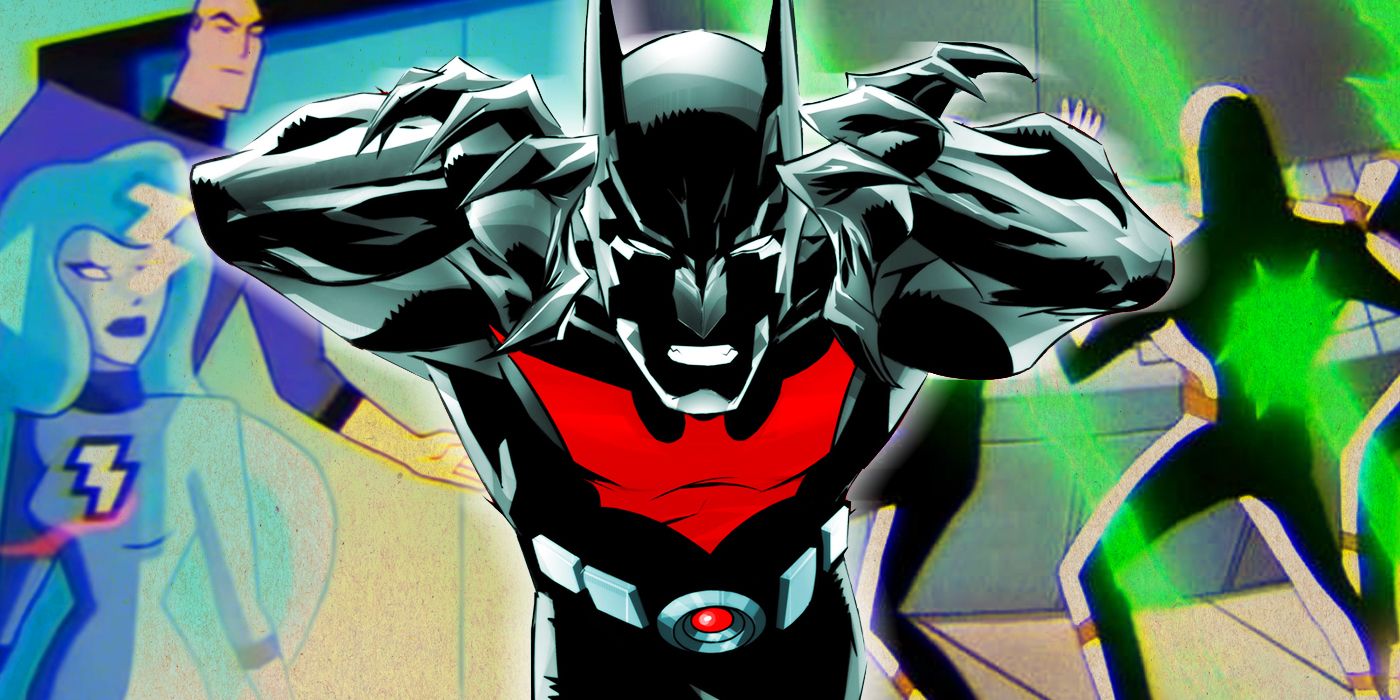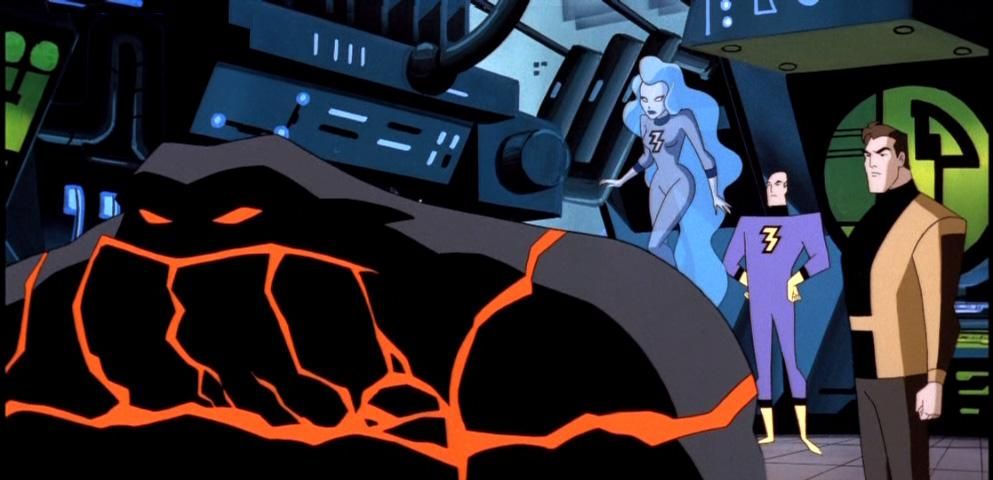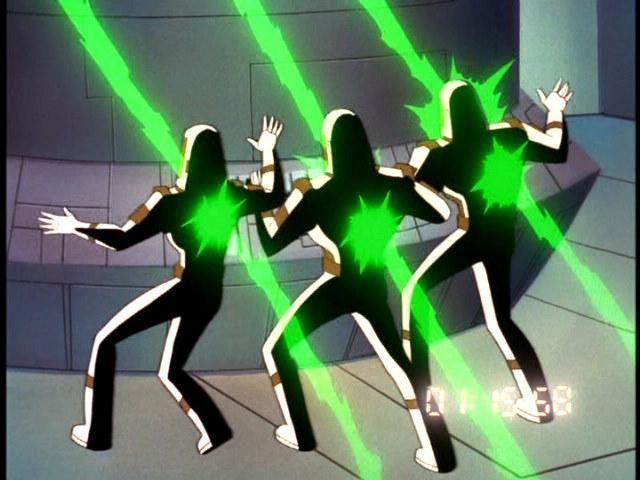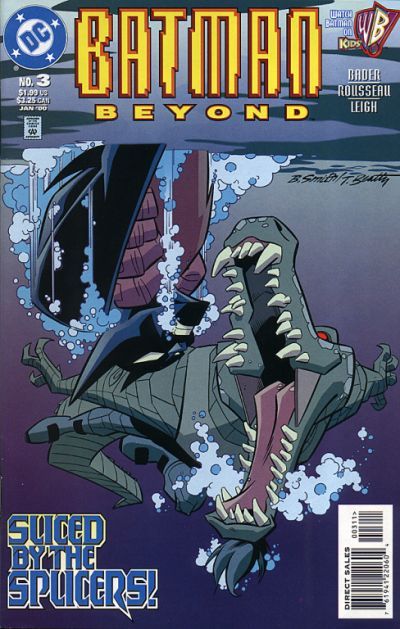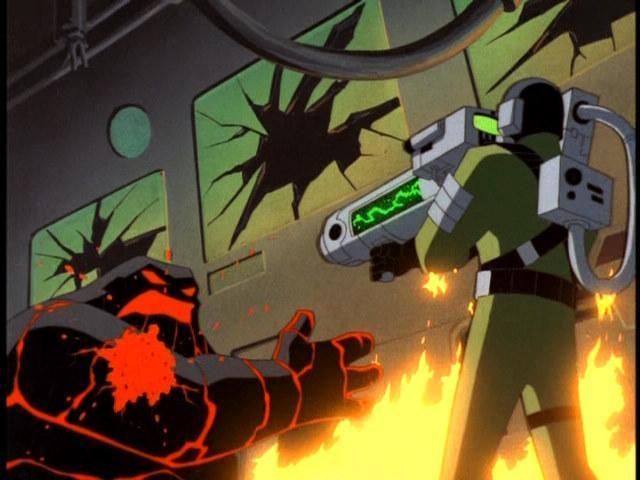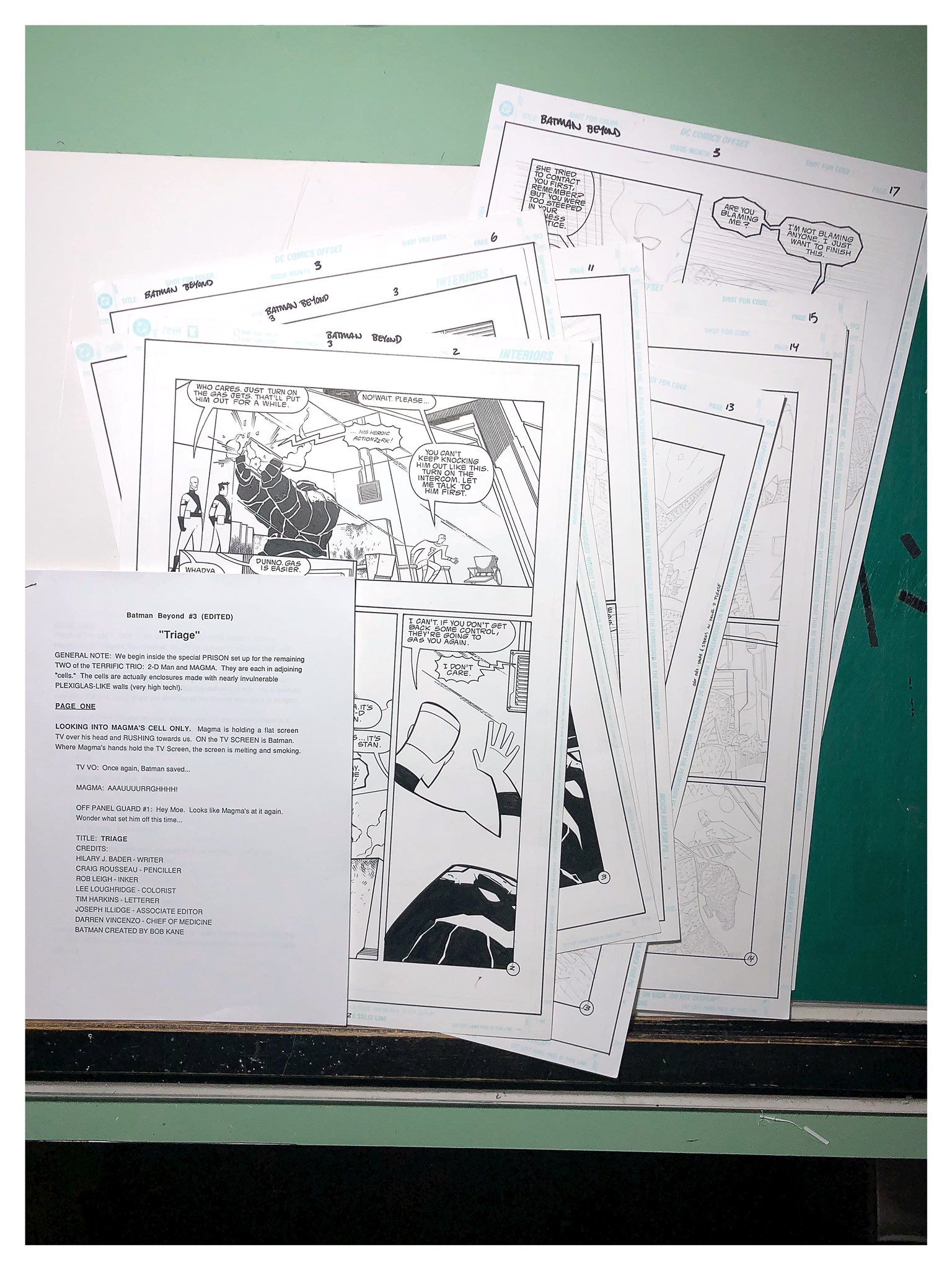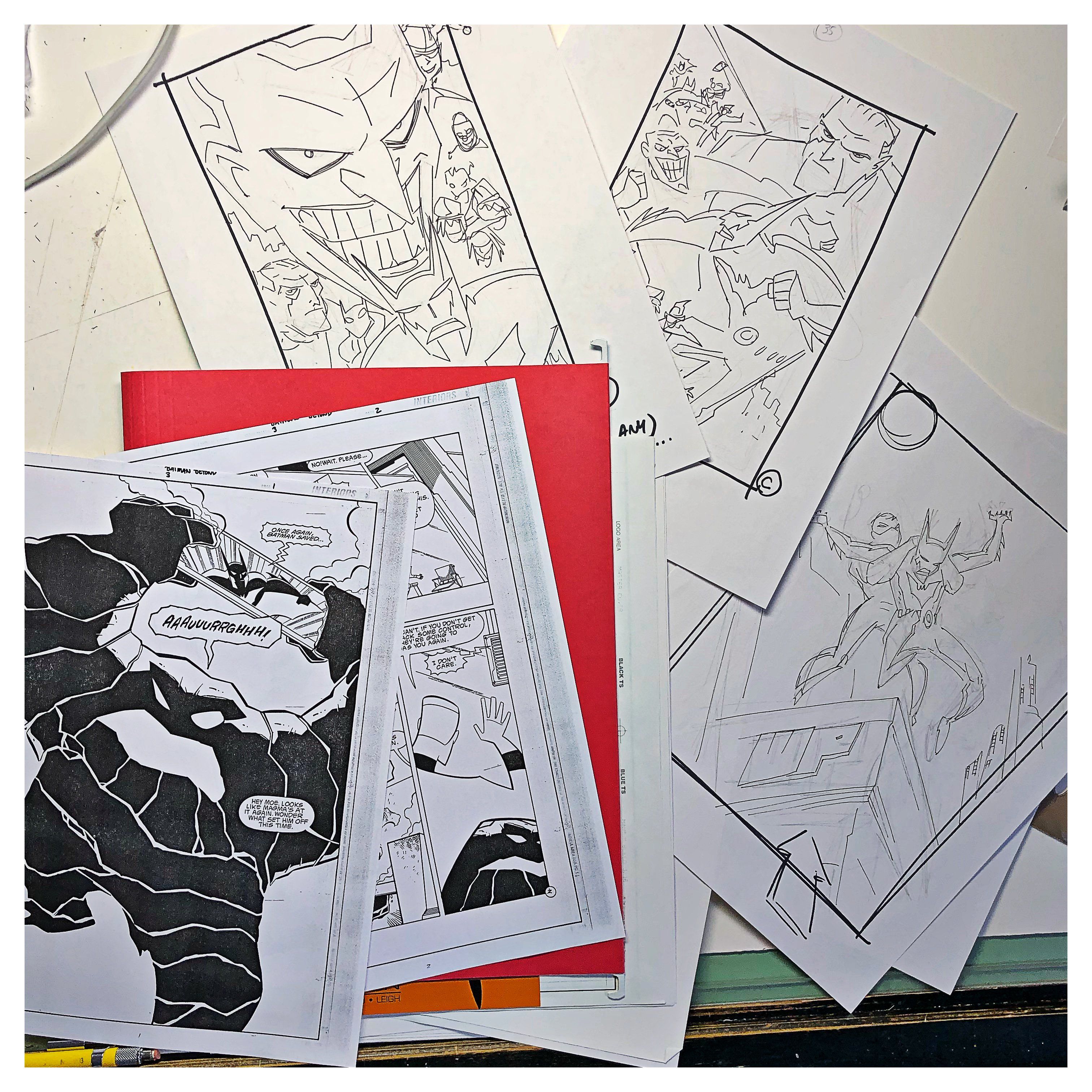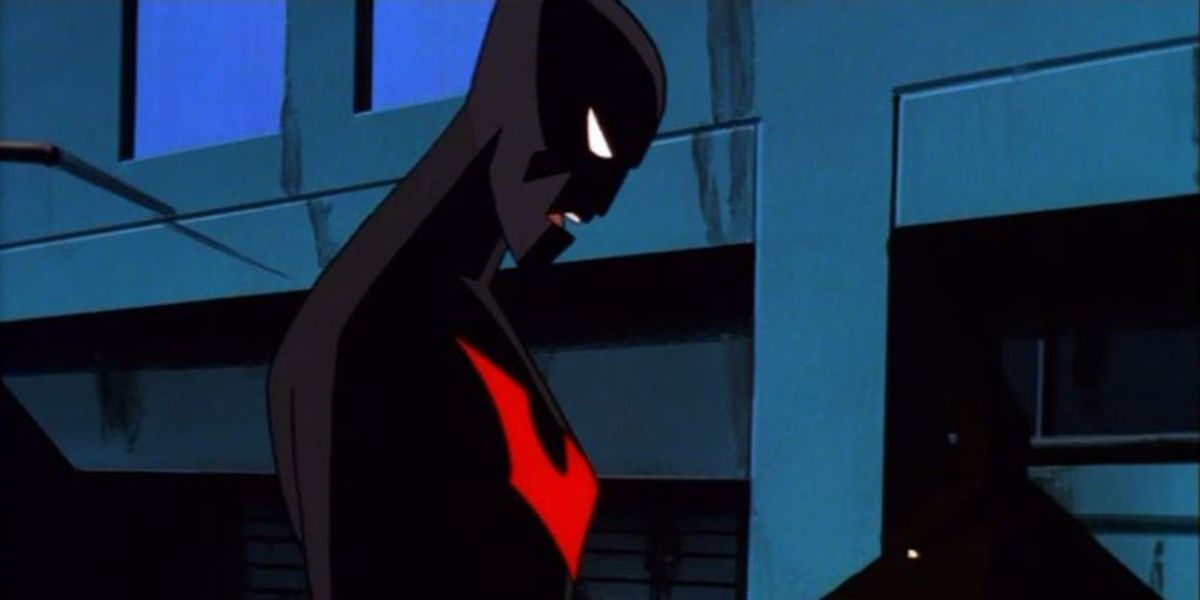Welcome to Adventure(s) Time's 142nd installment, a look at animated heroes of the past. This week, the time Batman Beyond faced a team of heroes who were not familiar in any way, promise. And if you have any suggestions for the future, let me hear them. Just contact me on Twitter.
Airing on Feb. 20, 1999, "Heroes" is the sixth episode of Batman Beyond, written by Rich Fogel and directed by Butch Lukic. The opening has Batman patrolling the corrupt streets of future Gotham (still not labeled Neo-Gotham), where a gang of rocket-pack thieves momentarily get the better of him. As he recovers, a woman in the form of blue mist passes by Batman, flying up and confronting the thieves. She's joined by a massive figure made of partially molten lava and an inhumanly flat and stretchable man.
Subsequent news reports label these heroes "The Terrific Trio" -- Freon, Magma, and the 2-D Man. They were once scientists, bombarded with radiation during a particle fusion experiment. Consequently, they transformed into super powered beings and made the selfless decision to become government-sponsored heroes. And the inspiration behind these creations isn't hard to guess, as their powers and personas echo the Fantastic Four, with Magma taking elements of both the Thing and Human Torch. (Another twist is to pair the Thing analogue romantically with the Invisible Woman analogue, instead of the Mr. Fantastic knockoff.)
It's questionable what percentage of the audience caught this joke. Comic book fans did, of course. But kids innocently watching a Saturday morning cartoon with no knowledge of the source material might've not been aware of the Fantastic Four. Their two-season animated series had been off the air for a few years by 1999, and in spite of a well-intentioned second season revamp, the show wasn't a massive hit, anyway. What seems obvious, however, is just how deeply the producers are amused by this. Batman Beyond already owes much of its mythology to the classic Stan Lee/Steve Ditko issues of Amazing Spider-Man, and now the first family of Marvel Comics is making a sneaky appearance on the show.
Batman Beyond, even though it was commissioned as a more "youthful" take on Batman, wasn't exactly the optimistic world of early 1960s Marvel Comics. The show's view of authority, of even heroism, has little in common with the environment that birthed Spider-Man and the Fantastic Four. So, it's not that surprising that subsequent events in "Heroes" take a cynical turn.
An unofficial fourth member of the Trio is Dr. Howard Hodges, a one-time colleague and their government liaison. Hodges didn't join his friends in the fateful experiment, we're told, due to a conflicting engagement. The truth is later exposed, however -- Hodges has long resented Magma, so he orchestrated what he thought would be a fatal laboratory accident to kill his "friend." What Hodges didn't expect was for his secret love, Freon, to join Magma in the experiment.
When his friends developed superpowers, Hodges sold their services to General Norman (whose unique mustache is either a reference to J. Jonah Jameson or Adolf Hitler. It's hard to tell with this show.) However, the group's genetic stability continually unravels, leading Hodges to believe they'll soon grow insane. Suspicious of Hodges, Magma breaks into his lab and has a brief confrontation with Batman, conveniently passing by and reminding us whose show this is. Magma's actions turn the Army against the Trio, leading to a messy battle at their headquarters. "The Army? I thought they were heroes, too," muses Batman, driving home the story's bleak message.
The Trio slip out of the battle and drag Hodges to the site of their fateful accident, where he's forced to reveal the truth. The alleged heroes have recreated the radiation experiment and, in spite of Hodges' pleas, are determined to destroy themselves and take all of Gotham with them. Batman arrives to stop the device from reaching critical mass, but all Trio members apparently die during the fight. A repulsed Batman walks past Hodges and asks if he's satisfied. Hodges, through tears, declares that these were his friends.
A memorable episode. Not only for its attempts at meta-humor, but for the seeming nastiness of its perspective. The Terrific Trio never again appeared in animation, but the third issue of DC's monthly Batman Beyond comic had an intriguing hint of their return. The solicitation for the January 2000 issue read: "It's the return of the Terrific Trio (last seen on the Kids' WB! animated series)! 2-D Man and Magma, the two surviving members of Gotham City's super-hero team of the future, are in custody after going berserk. But strange messages from Freon, their dead teammate, lead them to break out and initiate experiments to re-assamble her...using Batman as the energy source!" The story would come from Hilary J. Bader, who scripted several episodes of the cartoon, and be pencilled by Craig Rousseau.
Anyone searching that issue out today however, is bound to be surprised by the cover.
Batman Beyond #3 is in fact a follow-up to another episode, "Splicers." (And was actually covered during an early entry in this series... sadly the comment left by that episode's co-author Evan Dorkin has been lost to time.) So what happened to the original Batman Beyond #3?
For years, it's been believed that Warner Bros. was concerned about just how much the Trio resembled the Fantastic Four. Fans of this era will know how Warner Bros' corporate edicts impacted DC Comics, often cancelling announced projects or even pulping published books that made certain lawyers uncomfortable. There's also the Flex Mentallo case, which had DC keeping a popular story out of print for years, even after winning a legal battle over it.
Recently, the YouTube channel Watchtower Database interviewed "Heroes" writer Rich Fogel. When asked about legal issues surrounding the Trio, he stated: "There was some sensitivity about making them different enough that there wouldn't be legal jeopardy," while also indicating the producers viewed them as one-off characters. It's possible Warner Bros. was willing to allow one appearance from the Trio, but felt uncomfortable at the thought of them becoming recurring villains.
The DC Animated fansite has archived the comic's original color cover, but it's only a small thumbnail. Craig Rousseau has shared art from the aborted Batman Beyond #3 over the years, which made it to the lettering stage, and at least a few pages were inked. (Thanks to the Watchtower crew for archiving these and sending them along.) It's an interesting piece of lost media, still pretty obscure after over twenty years.
DESIGN-Y
This could be the Beyond episode with the strongest Kirby influence. Magma especially looks as if he would've worked easily as a Silver Age Kirby monster. Also, the background design for the Terrific Trio's lab was later recycled for a portion of Gorilla City in the Justice League episode "The Brave and the Bold."
CONTINUITY NOTES
Batman lifting a massive cylinder off of himself is another homage to Lee/Ditko Amazing Spider-Man, specifically the climax to #33's "If This Be My Destiny...!" These were the early days of everyone pulling out this homage. An issue of Peter Parker: Spider-Man also did this bit just a few months before this episode aired.
HEY, I KNOW THAT VOICE
Robert Davi, the character actor who played Franz Sanchez in the James Bond film License to Kill, voices Magma. Laura San Giacomo of Just Shoot Me fame portrays Freon. 2-D Man wasn't stunt cast, however, with veteran voice over actor Jeff Glen Bennett in the role, the voice of everyone from Johnny Bravo to the misguided robot HARDAC from Batman: The Animated Series. The duplicitous Howard Hodges is voiced by Kevin Dunn, a fantastic character actor unfortunately best known for playing Shia LaBeouf's dad in the Transformers films.
"YOU'RE A HERO, REMEMBER?"
1987's Fantastic Four vs. the X-Men had writer Chris Claremont teasing a conspiracy behind the creation of the Fantastic Four, one that doesn't present the team's father figure in a positive light. The story's conclusion allows Reed Richards off the hook, enabling the family of heroes to continue on their adventures. "Heroes" does no such thing, affirming that these "heroes" are anything but. And it's clear we're not meant to see the military in a heroic light by the story's end, either.
Who does that leave as the true hero? The obvious answer is Batman, although this isn't the iconic Bruce Wayne of Batman: The Animated Series. This is Terry McGinnis, a teenager still learning the ropes, living in a world of apathy, greed and corruption (we're told this in the show's opening credits!) This Batman's adventures often end with the teen indirectly killing his opponents and feeling not a shred of remorse. The majority of adults he encounters are either corrupt or clueless. It's a different view of heroism, made at least unintentionally amusing when you remember this show was conceived as a more kid-friendly take on Batman. Within the context of the series, this cynicism is justifiable, but some episodes are perhaps a little too grim. "Heroes" is based on a joke, but is rarely funny, and arguably too bleak for its own good.

